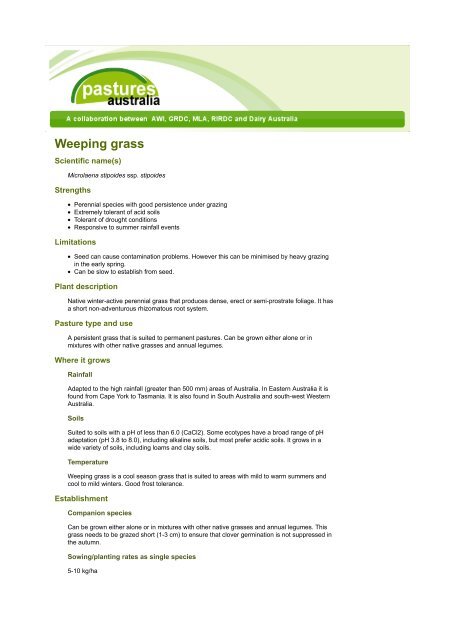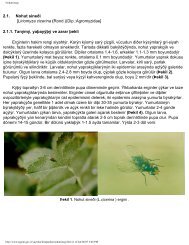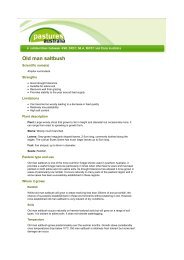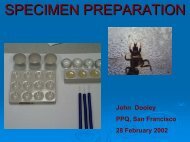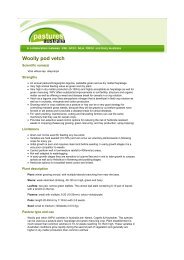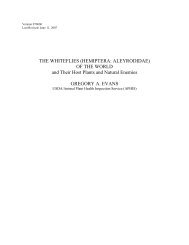Weeping grass
Weeping grass
Weeping grass
Create successful ePaper yourself
Turn your PDF publications into a flip-book with our unique Google optimized e-Paper software.
<strong>Weeping</strong> <strong>grass</strong>Scientific name(s)Microlaena stipoides ssp. stipoidesStrengthsPerennial species with good persistence under grazingExtremely tolerant of acid soilsTolerant of drought conditionsResponsive to summer rainfall eventsLimitationsSeed can cause contamination problems. However this can be minimised by heavy grazingin the early spring.Can be slow to establish from seed.Plant descriptionNative winter-active perennial <strong>grass</strong> that produces dense, erect or semi-prostrate foliage. It hasa short non-adventurous rhizomatous root system.Pasture type and useA persistent <strong>grass</strong> that is suited to permanent pastures. Can be grown either alone or inmixtures with other native <strong>grass</strong>es and annual legumes.Where it growsRainfallAdapted to the high rainfall (greater than 500 mm) areas of Australia. In Eastern Australia it isfound from Cape York to Tasmania. It is also found in South Australia and south-west WesternAustralia.SoilsSuited to soils with a pH of less than 6.0 (CaCl2). Some ecotypes have a broad range of pHadaptation (pH 3.8 to 8.0), including alkaline soils, but most prefer acidic soils. It grows in awide variety of soils, including loams and clay soils.Temperature<strong>Weeping</strong> <strong>grass</strong> is a cool season <strong>grass</strong> that is suited to areas with mild to warm summers andcool to mild winters. Good frost tolerance.EstablishmentCompanion speciesCan be grown either alone or in mixtures with other native <strong>grass</strong>es and annual legumes. This<strong>grass</strong> needs to be grazed short (1-3 cm) to ensure that clover germination is not suppressed inthe autumn.Sowing/planting rates as single species5-10 kg/ha
PalatabilityProduction potentialValuable feed for maintenance, particularly in the undulating and hilly land with moderatelyinfertile, acid and shallow soils.Livestock disorders/toxicityThere are no known animal health problems associated with this <strong>grass</strong>.CultivarsOvens (LIGULE 183): This <strong>grass</strong> was developed in the LIGULE (Low InputGrasses Useful in Limiting Environments) program. LIGULE was a collaborativeproject between the NSW Department of Land and Water Conservation andDepartment of Primary Industries Victoria funded by Meat and LivestockAssociation, the Land and Water Resources Research and DevelopmentCorporation. Ovens <strong>Weeping</strong> <strong>grass</strong> was selected from a <strong>grass</strong> population thatoriginated in the wheat-sheep zone near the NSW -Victorian border and hasconsiderable heat and drought tolerance. It is a larger plant which producesconsiderable dry matter of high grazing quality.Bremmer (LIGULE 704): This <strong>grass</strong> was also developed in the LIGULE program.It was selected from a <strong>grass</strong> population that originated in the medium rainfall zonein southern NSW where grazing is the principal activity. Bremmer <strong>Weeping</strong> <strong>grass</strong>is an upright plant with medium textured leaves and a strong tolerance to acid soilconditions.Shannon: This variety was bred by the University of New England forrevegetation and pasture applications. It has performed well on very shallow soilsunder exposed conditions. It grows well in higher altitude situations havingperformed extremely well in the higher test sites of north-east Victoria, but alsopersists well at lower altitudes.Griffin: Griffin <strong>Weeping</strong> <strong>grass</strong> is ideal for a high quality lawn and for passiverecreation. Once established, it is low maintenance and requires minimalwatering. It grows in shade. This variety was developed by the University of NewEngland.Wakefield: Wakefield weeping <strong>grass</strong> was selected for pastoral use. This varietywas developed by the University of New England.Tasman: This variety was bred by Native Seeds Pty Ltd especially for the turf andamenity market in the cooler climates of Australia. It has a deep green colour, isfine textured and has dense foliage. When fully established, it is very hardy andcan withstand hot, dry conditions.Burra: Burra <strong>Weeping</strong> <strong>grass</strong> was developed by Native Seeds Pty Ltd. It is aversatile all round <strong>grass</strong> with a deep green colour. It has high drought toleranceand is tolerant of acid soils. Burra is well suited for lawns or for revegetation.Further informationWaters C, Whalley W, Huxtable C (2001) ‘Grassed up. Guidelines for revegetating withAustralian native <strong>grass</strong>es.’ (NSW Agriculture: Orange)http://www.agric.nsw.gov.au/reader/gu-quickref/gu712.htmhttp://www.agric.nsw.gov.au/reader/gu-species/gu81mic.htmCole IA, Metcalfe J (2003) Management guidelines for seed production of Australian <strong>grass</strong>cultivars. 2nd edn. (Department of Infrastructure, Planning and Natural Resources: Sydney)Cole IA, Metcalfe J (2004) The effects of herbicides on Australian native <strong>grass</strong>es, a databaseof published literature. (Department of Infrastructure, planning and Natural Resources: Sydney)http://www.acmer.uq.edu.au/publications/attachments/DIPNRseedprod2ndedn.pdfhttp://www.nativeseeds.com.au/categories.asp?cID=54http://www.native<strong>grass</strong>es.com.au/revegetation.htmlAcknowledgementsInformation has been adapted from:Waters C, Whalley W, Huxtable C (2001) ‘Grassed up. Guidelines for revegetating with
Australian native <strong>grass</strong>es.’ (NSW Agriculture: Orange)Cole IA, Metcalfe J (2003) Management guidelines for seed production of Australian <strong>grass</strong>cultivars. 2nd edn. (Department of Infrastructure, Planning and Natural Resources: Sydney)Cole IA, Metcalfe J (2004) The effects of herbicides on Australian native <strong>grass</strong>es, a databaseof published literature. (Department of Infrastructure, planning and Natural Resources: Sydney)Author and dateMeredith MitchellJuly 2007


